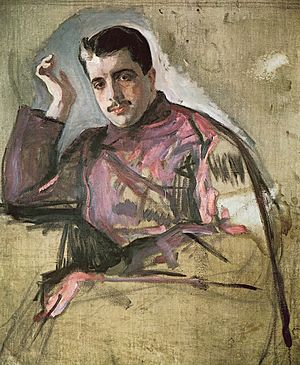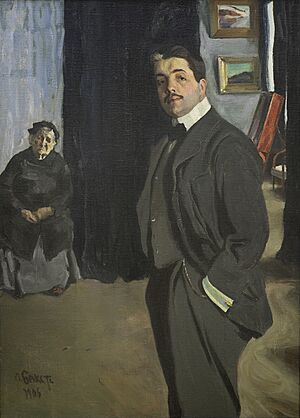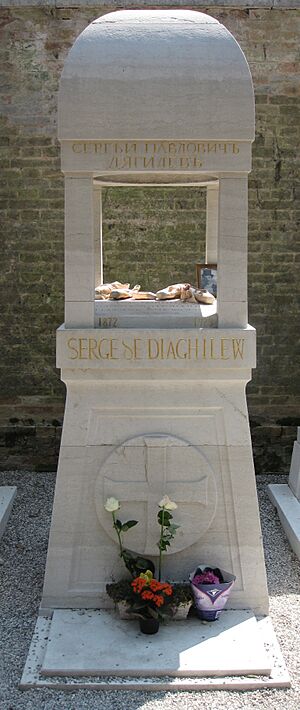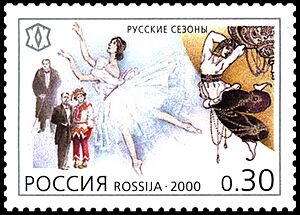Sergei Diaghilev facts for kids
Quick facts for kids
Sergei Diaghilev
|
|
|---|---|
| Сергей Дягилев | |

Diaghilev in 1910
|
|
| Born |
Sergei Pavlovich Diaghilev
31 March 1872 Selishchi, Novgorod Governorate, Russian Empire
|
| Died | 19 August 1929 (aged 57) |
| Resting place | Isola di San Michele, near Venice |
| Nationality | Russian |
| Occupation | Art critic, patron and ballet impresario |
| Known for | Founder of the Ballets Russes |
| Relatives | Dmitry Filosofov (cousin) |
| Signature | |
Sergei Pavlovich Diaghilev (/diˈæɡɪlɛf/ DEE-ag-IL-ef; Russian: Серге́й Па́влович Дя́гилев, IPA: [sʲɪˈrɡʲej ˈpavləvʲɪdʑ ˈdʲæɡʲɪlʲɪf]; 31 March [O.S. 19 March] 1872 – 19 August 1929) was a famous Russian art critic and impresario. He is best known for creating the Ballets Russes. This ballet company helped many famous dancers and choreographers become well-known.
Diaghilev's career had two main parts. The first was in St. Petersburg from 1898 to 1906. The second was after he left Russia, from 1906 to 1929.
Contents
Sergei Diaghilev's Early Life

Sergei Diaghilev was born in Selishchi, Russia. His father was a noble officer. Sadly, Sergei's mother died soon after he was born. In 1873, his father married Elena Panaeva, who raised Sergei as her own child.
The Diaghilev family home in Perm was a center for culture. They often hosted musical evenings. Famous composer Modest Mussorgsky was a frequent guest. Sergei composed his first song at age 15. When he went to Saint Petersburg Imperial University, he also took music lessons. His teacher was Nikolai Rimsky-Korsakov.
Sergei took six years to finish university instead of the usual four. He said he used this time to "look around" and find his true interests. Seven months after graduating, he opened his first art exhibition.
Diaghilev's Time in St. Petersburg

During his university years, Diaghilev met a group of friends who loved art. They called themselves "The Nevsky Pickwickians." This group included Alexandre Benois and Léon Bakst. Benois helped Diaghilev learn a lot about Russian and Western art. In just two years, Diaghilev became very knowledgeable. He was respected as one of the most learned in the group.
In the late 1890s, Diaghilev organized several art exhibitions. These shows aimed to introduce modern artists to the public. In 1897, an exhibition of British and German watercolor artists was a big success. He repeated this success in 1898 with Russian and Finnish artists. These included works by Mikhail Vrubel and Valentin Serov. He also showed young Russian painters in Germany.
Even without a lot of money, Diaghilev gained support from important people. These included the Grand Duke Vladimir Alexandrovich of Russia and even Nicholas II.
The Russian-Finnish exhibition of 1898 was the first event of a new art group. This group, called "Mir iskusstva" (World of Art), was started by Benois and Diaghilev. They soon launched a magazine also called Mir iskusstva. The magazine promoted modern art. Diaghilev was the art director. He designed the publication and wrote essays.
In 1905, Diaghilev opened a huge exhibition of Russian portraits. It featured over 4000 paintings. Diaghilev himself traveled to find the portraits. He also wrote a detailed catalog. The exhibition was designed by Benois. It was very innovative and impressed many visitors. This show made Diaghilev a top figure in the art world.
Diaghilev wanted to share Russian art with the world. In 1906, he organized a large exhibition in Paris. It showed 750 works by 103 Russian artists. The exhibition was designed by Léon Bakst. It was a huge success and helped make Russian art popular in France. Diaghilev was even offered a special award, but he refused it in honor of Bakst.
Working with Imperial Theaters
In 1899, Diaghilev started working for the Imperial Theaters. He became responsible for producing their annual magazine. He completely changed the magazine, making it a luxurious publication. It included essays, playbills, and many pictures. He invited his friends from "Mir iskusstva" to help with the design. Diaghilev also found sponsors and advertisers.
Diaghilev started attending ballet rehearsals. He was interested in young dancer Mathilde Kschessinska. Their friendship lasted throughout their lives.
Diaghilev brought his artist friends to work on theater sets and costumes. Artists like Alexandre Benois and Léon Bakst began designing for the Imperial Theaters. In 1900, Diaghilev was put in charge of staging the ballet Sylvia. His plans were very grand. However, he had disagreements with the theater staff. In 1901, he was fired. This scandal also led to the firing of his boss. Diaghilev then went abroad to pursue his other plans.
The Ballets Russes
Russian Historical Concerts
The success of his 1906 art exhibition in Paris gave Diaghilev an idea. He wanted to introduce Russian music to Paris. In 1907, he organized "Concerts historiques russes." These concerts featured famous composers like Nikolai Rimsky-Korsakov and Sergei Rachmaninoff. Famous singers like Feodor Chaliapin also performed. The tour was supported by royal patrons.
In 1908, Diaghilev brought Mussorgsky's opera Boris Godunov to Paris. Feodor Chaliapin starred in it. Artists designed the sets and costumes. The tour was a huge success. However, it lost money.
Founding the Ballets Russes
By 1909, Diaghilev faced financial challenges. The Russian government stopped funding his tours. He turned to his friend, Misia Sert, for help. With her efforts, his company was able to rent a theater in Paris.
At first, Diaghilev was not very keen on ballet. He once said that "anyone with no special wit can enjoy it." Despite this, in 1909, the first "Saison Russe" (Russian Season) of ballet took place. Its success was enormous.
The first season featured ballets like Le Pavillon d'Armide and Les Sylphides. Leading dancers like Vaslav Nijinsky, Anna Pavlova, and Tamara Karsavina became world-famous stars. Diaghilev's new idea was to combine dance, music, and visual arts. He brought together set designs and costumes into one amazing performance.
Diaghilev worked with many great composers. He commissioned new ballet music from Claude Debussy, Maurice Ravel, Erik Satie, and Sergei Prokofiev. He also worked with famous choreographers like Michel Fokine and Léonide Massine.
Léon Bakst was the artistic director for the Ballets Russes. Together, they created a more complex ballet style. This style included show elements to attract a wider audience. The unique look of the Ballets Russes influenced art styles like Fauvism and Art Deco.
Diaghilev's most important composer was Igor Stravinsky. Diaghilev heard Stravinsky's early music and was very impressed. In 1910, he asked Stravinsky to compose The Firebird. This was followed by Petrushka (1911) and The Rite of Spring (1913). They also worked with artist Pablo Picasso on ballets like Pulcinella.
Later Years and Influence
After the Russian Revolution in 1917, Diaghilev stayed outside Russia. He continued to lead the Ballets Russes. In 1921, he staged Tchaikovsky's The Sleeping Beauty in London. It was a grand production, but it lost a lot of money.
The Ballets Russes continued to innovate. Diaghilev was a pioneer in using new musical styles in ballet. For example, when Ravel used a special rhythm in his ballet Daphnis and Chloe, dancers would sing "Ser-gei-dia-ghi-lev" to keep the correct beat.
Many dancers from Diaghilev's Ballets Russes went on to create their own ballet traditions. George Balanchine founded ballet in the United States. Ninette de Valois and Marie Rambert did the same in England. Serge Lifar helped revive the Paris Opera Ballet.
Diaghilev's Personal Connections
Diaghilev's life was closely tied to the Ballets Russes. He worked closely with many talented artists and dancers. One of his most famous dancers was Vaslav Nijinsky. Diaghilev helped Nijinsky become a world-renowned star.
Diaghilev was known as a demanding leader. Dancers sometimes found him frightening. Ninette de Valois said she was too afraid to look him in the face. George Balanchine recalled Diaghilev using a cane to show his displeasure during rehearsals. However, he was also capable of great kindness. He would put the needs of his dancers and company first.
Dancers like Alicia Markova and Tamara Karsavina remembered Diaghilev as a stern but caring father-figure. He often lived simply to fund his company. He spent a lot of money on rare books, but his own suits were sometimes worn out. The 1948 film The Red Shoes is a story inspired by the Ballets Russes.
Death and Legacy
Diaghilev had a lifelong fear of dying in water. He avoided traveling by boat. He died from diabetes in Venice on August 19, 1929. His tomb is on the nearby island of Isola di San Michele, close to the grave of Igor Stravinsky.
Diaghilev's work and influence are still remembered today. The Ekstrom Collection of the Diaghilev and Stravinsky Foundation is kept at the Victoria and Albert Museum in London.
On March 31, 2017, Google celebrated Sergei Diaghilev’s 145th birthday with a special doodle. The Diaghilev Contemporary Art Museum in Saint Petersburg State University is named after him.
Images for kids
See also
 In Spanish: Serguéi Diáguilev para niños
In Spanish: Serguéi Diáguilev para niños
- List of dancers







